One of the consistent statements we hear from visitors to Sleeping Bear Dunes National Lakeshore is that Lake Michigan’s Manitou Passage looks like the Caribbean. When the sun shines on these crystal clear waters, the deep blue and turquoise colors are breathtaking.

Peaceful scenes such as the 1000 foot freighter American Spirit steaming past the North Manitou Shoal Lighthouse in the distance are common here in Leelanau County. Looking at this, it’s difficult to imagine the fury the lake can unleash…often within a matter of minutes. Many a mariner has been caught unaware in these waters, and their ships have been wrecked near these shores.
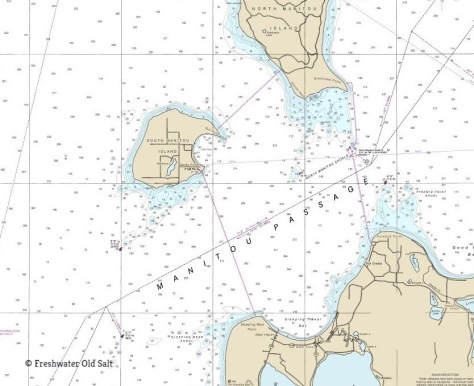
This chart shows the ideal route that ships aim for as a dotted line. By going this direction a vessel can shave 60 miles off of their trip between Mackinac and Chicago, as opposed to going west of the islands. This archipelago can also act as protection from strong westerly winds. During a fierce gale in 1913, the steamer Illinois found refuge in South Manitou Island’s crescent-shaped harbor by nosing into the beach and keeping the engines running forward for 50 continuous hours. It was at that point that the wind subsided enough for a crewman to go ashore and secure the ship to a large tree, so they could power down the ship.
Back in late 1800’s and early 1900’s, there weren’t any decent roads in northern Michigan and the lakes were considered a highway. It wasn’t unusual for 100 vessels to be in the Manitou Passage on a given day, as it was also a major fueling station. Wood was the fuel of choice back then for steamships, and these shores had plenty of it. All of that traffic, combined with the occasional storm, brought about many shipwrecks. Over 100 vessels were known to have run aground, with many of them being refloated and saved.

Over 50 were left in place to be dismantled by the power of Lake Michigan’s waves.
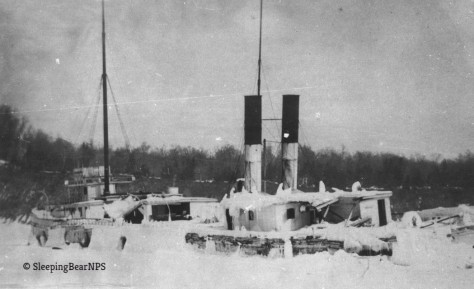
One such ship was the Walter L. Frost, which ran aground along South Manitou Island’s shore in 1903. It wasn’t too many years until nothing remained above the lake’s surface.
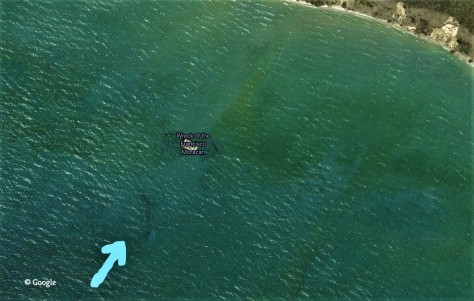
In 1960, the Liberian freighter Francisco Morazan grounded on South Manitou Island after losing power, running over the subsurface remains of the Frost (blue arrow) in the process.
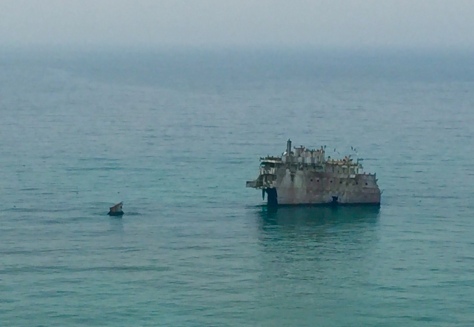
Today, the remains of the Morazan are a visible reminder of just how brutal this lake can be to a ship….

…and a flyover will reveal many of the other wrecks in the passage.
We had an excellent example of the moodiness of Lake Michigan this past week.

This is a photo of the 620 foot long Mississagi, heading south through the fog towards Muskegon on Thursday.
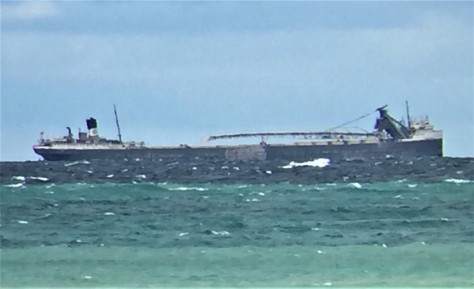
On the ship’s return northward on Friday, it was met with 50 + MPH gusts coming from the northwest. As a reference, this photo was taken on the east side of the Manitou Islands, so the ship was not experiencing the high waves that were occurring out in the open lake on the west side.
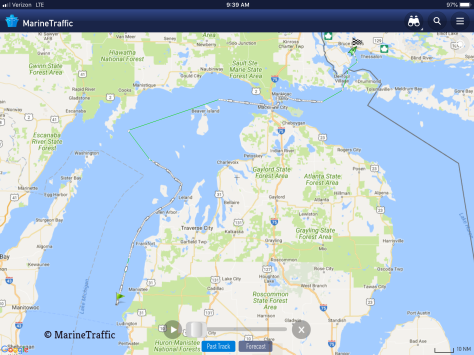
But look what the captain did once he was past Leland and North Manitou Island. With the full brunt of the gale hitting them broadside, he choose to turn the bow northwestward and head across the lake to calmer waters along the Upper Peninsula shore. Once there, he turned northeastward and headed towards the Straits of Mackinac. As he passed Mackinac Island, he witnessed the only shipping casualty of that day’s storm. The tug and barge Defiance/Ashtabula had run aground. Once the gale subsided, that ship was able to be freed from the clay bottom with little damage. The storm was strong enough to not only close the Mackinac Bridge to high profile vehicles but also the Soo Locks. That rarely happens.
Nowadays, rescues are performed by the Coast Guard with helicopters and enclosed motor lifeboats. Back when the Illinois sought shelter in South Manitou Harbor in 1913, the U.S. Life Saving Service (USLSS) had other equipment at their disposal.
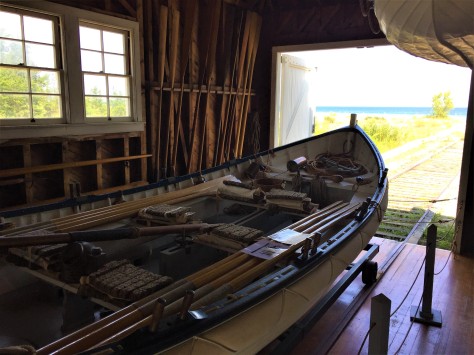
For the wrecks that were farther than 500 yards from shore, the USLSS would use an open surfboat to rescue stranded sailors. The Sleeping Bear Point Life Saving Station performed 5% of their rescues in this manner. But since most wrecks occurred along the shore, a beach apparatus was employed to bring the crew to safety.
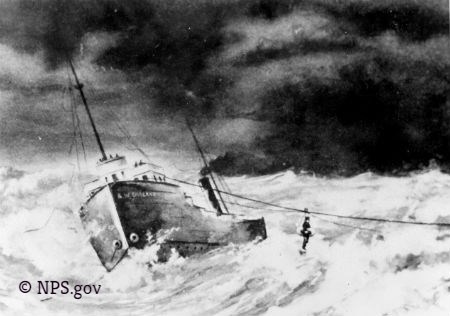
That consisted of several lines, a breeches buoy, and a cannon (called a Lyle Gun) to fire the initial line over the ship. The breeches buoy was nothing more than a pair of pants (britches) attached to a life ring. What this apparatus amounted to was similar to a modern day zip line.
Here at Sleeping Bear Dunes National Lakeshore, we perform a daily demonstration (summer months only) of the beach apparatus using young volunteers from the audience as surfmen. This program is called Heroes of the Storm.
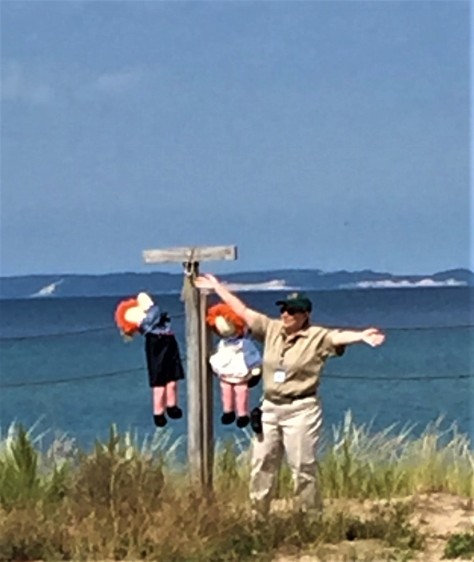
Here is Captain Diana with her crew, Raggedy Ann and Andy, calling for help from her stranded ship. A simulated Lyle Gun fires a projectile with a line out to the ship, which allows the captain to drag out the heavier rescue lines.
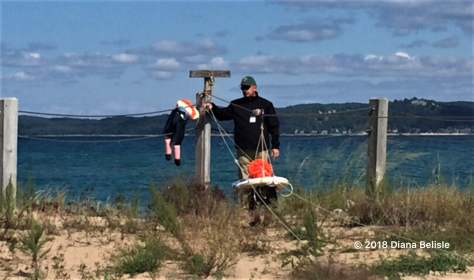
Here is Captain Jim on another occasion sending Ann towards the shore in the breeches buoy.
A special treat occurs on Thursdays, right after the Heroes program. That is the day an actual Lyle Gun is fired. This cannon is the only gun invented by the U.S. Army to save lives instead of take them.
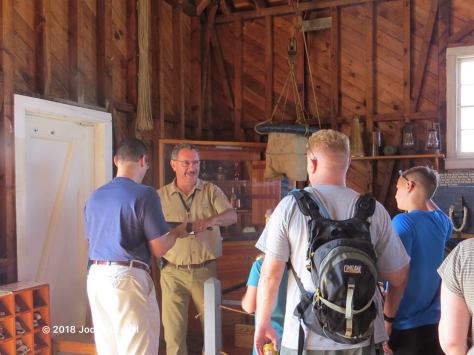
An 18-pound projectile, similar to the one I am holding here, is loaded into the Lyle gun. A 200-yard long shot line is tied to the end of it. That is fired out into Sleeping Bear Bay each week. Once the line is hauled back in, it is hung along the station’s picket fence to dry. Once dried out, it is the park volunteer’s job to ‘fake’ the line into what is called the faking box.
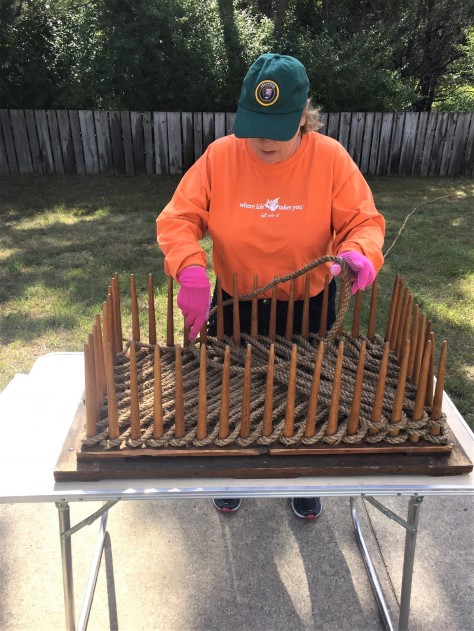
Here is Diana winding the rope around the faking box pegs.

And here we are with 200 yards of faked rope. There is a lid that is put over this afterwards. Once at the beach, the whole thing is turned over and the rope is slid off the pegs and into the lid. Hopefully it doesn’t tangle when they fire the gun! Let’s find out in this slo-mo video. This took place the day we faked the rope:
So there you have it. That brought a smile to our faces!
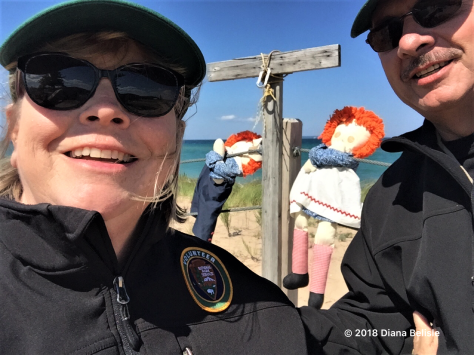
Until next time, safe and happy travels to all!

Interesting history of all the ship wrecks in the area. They have some intense and unexpected storms that can really do some damage!
LikeLiked by 1 person
We were amazed at the depth of the history here, Jim. We’ve been coming here for years and have barely scratched the surface!
LikeLike
I had no idea you can still see some of the wrecks under the water! Fascinating being able to track that ship’s route in the storm, makes it all very real. Love that you and Diana are both “captaining” the Raggedy kids ship during the rescue :-))) Now you can put faking box on your resumes!!
LikeLiked by 1 person
We’ve gotten really good at faking that rope, Jodee. We alternate on each pass.
I’m actually loving that app, even though it could be improved upon.
LikeLike
The view from the top of Sleeping Bear Dunes is spectacular. I had no idea there were so many wrecks out there!
LikeLiked by 1 person
It’s crazy how often it used to happen, Beth. Thank goodness for GPS! That view is from the Islands Overlook on the Alligator Hill trail, if you are ever up here looking for it. It’s definitely one of the sweetest viewpoints at Sleeping Bear.
LikeLiked by 1 person
We drove to the top and walked on a trail for a view. I don’t know what trail it was. I enjoyed reading your post.
LikeLiked by 1 person
I love how much you are geeking out on the cool things you are learning! That rope faking is awesome! I’m with Jodee, put that on your resume and you’ll be set!
LikeLiked by 1 person
Nautical history is far more interesting than I thought, Linda! Couple that with the dynamics of a stormy sea and it really gets exciting. Thanks again for that app reference…it has been a huge interpretation help. Nothing better than walking up to someone who spotted a ship in the distance and giving them the name and facts related to it. Total geeking out! 😊
LikeLike
It’s such a beautiful area with lots of interesting history. It’s too bad we just missed having you guys as our guides.
LikeLiked by 1 person
Remember, we learned a lot from YOUR post! You two did an excellent job of covering the area! 😊
LikeLike
Very interesting information. I knew there were a lot of shipwrecks in that area. Boy, that rope just kept going and going in the video. That’s a lot of rope to rewind! Sure sounds like a wonderful experience this summer.
LikeLiked by 1 person
It really is cool to watch that rope, isn’t it Pam? So glad it didn’t tangle!
LikeLiked by 1 person
I love the color of those lakes! Looks like a lot of work faking all that rope! How long did it take? Very cool to watch the Lyle gun fire in slo mo. That really goes out far.
LikeLiked by 1 person
The upper lakes are all like that, Debbie. Very pretty. Probably about 1/2 hour to fake the rope. We are a little faster at it than when we started. 😊. The rope was still a bit damp from rain that we had…it usually goes a good 50 yards farther than that with a dry rope.
LikeLike
My wife, Pat, and I snorkeled on the Morazon when we were backpacking on South Manitou Island many, many years ago. I also snorkeled on the Three Brothers which was sunk next to the harbor on South Manitou. As you have said, it’s more fun to see history where it happened than in a museum.
LikeLiked by 1 person
That is really cool, Bob! The Three Brothers is neat in that it still looks like a ship.
LikeLike